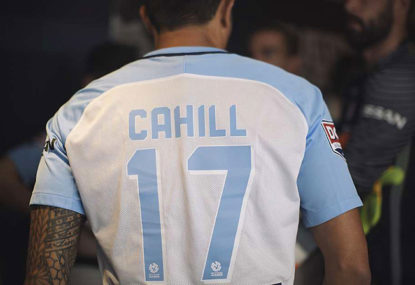Thrilling finishes, goalie heroics and a Sky Blue derby: The A-League players who were the difference in Round 24
Mathew Leckie played a pivotal part in Melbourne City claiming an 8-nil win; playing a role in several of his team's goals.

He came, he scored, he went off with an injury.
Tim Cahill limped off with a suspected damaged lateral knee ligament with a substantial portion of the FFA Cup final still to play, but not before he had provided the sort of limelight-bathed moment he tends to.
Having staged a running battle of elbows and heads with Matt Jurman all evening, it took a slightly offset corner routine – played short and then deep, with the cross coming in from a tricky recessed position – for Cahill to ease Jurman away for the first time.
The connection Cahill made was flush with the ball, a thudding kiss, a textbook example of heading technique. It flew back across Danny Vukovic, and nestled into the bottom corner.
Just as a concussed seagull had to be aided off the pitch, and stroked lovingly by a ground official, so Cahill had to be a little later – albeit with less stroking – after Josh Brillante rammed his leg into and through the very hinging point of Cahill’s knee as it was planted in the turf.
As unfortunate as it was to see Cahill limp off, he had already done his job.
And it was a night custom-made for Cahill, not just because of the grand occasion, but because of how the frenetic energy that ran through the centre of the contest pushed the action outward, towards the wings.
City fielded Nicolas Colazo, a winger, as their left-back. Within 30 seconds of the game starting, a high-speed encounter involving Luke Brattan and Michael Zullo next to the touchline spurred the Sydney bench to jump up in outrage, and a brief display of posturing and pinching caused the match to halt the match for a caustic minute.
This was the tone that would linger; the sparks would spit and fizz on the margins of the pitch, and John Van’t Schip had anticipated how important the room out there would be – compared to the almost totally congested centre – and placed the slippery Colazo on the wing accordingly. With increased wing-play comes the increased emphasis on the conversion of crosses; enter Cahill.
It was Sydney who made that midfield corridor so inhospitable. Brillante and Brandon O’Neill were tigerish, with Alex Brosque dropping back into deeper areas to add to the numbers.
The first half, in particular, was so tetchily contested; in that first period, the entire Melbourne City team managed just five passes into the box, and completed just one of four crosses.
These two teams hadn’t met this season so, in the heady, charged circumstances of a cup final, the battle in midfield was a frenzied struggle for supremacy that left little room for the subtler side of the game.
But the little room that was left was filled almost entirely by Bruno Fornaroli.
The Uruguayan was a terrible thorn in the side of every Sky Blue foe, and his quickness of foot and mind meant only he could survive the most feverish periods of the match, strutting like some otherworldly sprite, dancing through the maelstrom. He was awarded the Mark Viduka Medal for best on ground.
Really though, this match betrayed a certain fatal reservedness on the part of Graham Arnold.
It appeared as though the primary mandate he gave his team was to make City’s life difficult, with Sydney’s own creative ambitions forced slightly out of mind.
The Sky Blues were very direct, making 81 long passes in the game, significantly more than City, especially during the taught final stages when they were searching frantically for an equaliser.
These attacking methods were ill-suited, not just to the occasion, but to the team itself; eight times the Sydney attackers were caught offside, and there were a handful of additional sequences in which a Sydney player made no attempt at the ball due to their offside status.
One wondered, before kick off, whether we would see the Sydney team that had scored freely throughout their first seven league games turn up for this final, or the team that had turgidly drawn 0-0 with Adelaide in their eighth. It was the latter.
Michael Zullo, against Perth in Sydney’s Round Six 4-1 win, had nine open play touches in, or in line, with the Perth box, deep in their half. In this match he had three.
In Sydney’s 1-1 draw with Brisbane in Round Seven, ten of their shots came from inside the Roar box; in this match, they had just two.
When Arnold reigned over that Central Coast team of his, he always had the potential to send a side out that could just as easily illuminate an occasion as it could sour it with negativity. It seems as though, having decided that his team shouldn’t go toe-to-toe with the creativity of City, his plan to spoil their fun backfired.
Because, as Tim Cahill said after the match, “It’s just one moment in 90 minutes, mate… In games, it’s all about waiting, and being patient.”
Sydney’s approach meant City were forced to rely on a moment of individual quality to break through the stalemate. Arnold’s mistake was forgetting City have a more than a handful of quality individuals.
Ivan Franjic’s cross was swooped in, the ball almost searching for Cahill’s forehead, like a tearful shore-leave sweetheart would her enlisted beloved at a bustling train station.
It seems so silly of Arnold, in the stunning, silent clarity of hindsight, to bank on Cahill not ascending to the fore at the critical moment.
So, City have their first gleaming cup, two and a bit years after those movers and Sheikh-ers took up office. They now turn their minds to closing the gap Sydney have forced open ahead of them in the league.